Broas Castelares (Portuguese Sweet Potato Cookies)
This post may contain affiliate links. See my disclosure policy.
A traditional treat during the Christmas holidays, these Portuguese cookies (broas castelares) are packed with sweet potatoes, dried coconut, ginger, orange and more!
Portugal is not only the oldest state on the Iberian Peninsula, it’s one of the oldest in Europe with settlements dating back to prehistoric times. During the Renaissance, Portugal was one of the world’s major economic and military powers – Portuguese explorers pioneered maritime exploration, established the first global empire, and Portuguese merchants monopolized the spice trade. Portugal’s prominent global role continued until the great earthquake of 1755 when almost the entire city of Lisbon was destroyed. But Portugal forever left an indelible mark on the world, a profound cultural and architectural influence along with a legacy of 300 million Portuguese speakers.
Though Lisbon is relatively “new”, having been largely rebuilt since it’s 1755 destruction, it has retained much of its long-held traditions and its rich, unique culture. One of the things that comes to mind when you picture Lisbon are the azulejos – the beautiful and elaborately painted, glazed ceramic tiles that line church buildings, walls and homes. They reached their peak of popularity during the 16th and 17th centuries and sadly started falling out of favor in the early 20th century.
Some buildings have still maintained them as symbols of Lisbon’s rich tradition while the tile remnants of other buildings, including those destroyed by the earthquake, can be found for sale in antique stores. We found samples dating back to the 1600’s. We really enjoyed exploring these antique shops during our trip to Lisbon and we selected a couple of these antique tiles to bring back home with us, literally pieces of Portugal’s history.
Lisbon is a beautiful city with a rich heritage and our time there definitely whetted our appetite for a return visit.
I want to share a very traditional treat with you from Portugal called Broas Castelares which can be described as Portuguese sweet potato cookies and are especially popular during the Christmas season. The creation of these cookies is attributed to the Castelar brothers who owned the Confeitaria Francesa in downtown Lisbon in 1860.
There are different variations of these pastries, but they’re generally comprised of a combination of sweet potato, cornmeal, wheat flour, almond meal, shredded coconut, and often orange and/or candied ginger. They’re dense and filling and one or two cookies goes a long way.
These cookies are quite unique and feature a very dominant sweet potato flavor. If you’re not a sweet potato fan, I’ll tell you now, these cookies are not for you. However, if you are, these Broas Castelares cookies will be a very welcome treat indeed!
Let’s get started!
Pierce the sweet potatoes all over with a fork and bake in the oven at 400 degrees F for 45 minutes or until soft.
Let the sweet potatoes cool for few minutes then scrape out the flesh.
Run the sweet potato flesh through a potato ricer.
Place the sweet potato in a small-medium pot with the sugar. Stir over medium heat until the sugar is dissolved to liquid.
Add the lemon zest, orange zest and candied ginger. Increase the heat to medium-high and simmer the mixture for 5 minutes, stirring constantly to prevent scorching.
Remove from heat and add all remaining ingredients except for the eggs, orange blossom water and egg yolk. Stir to thoroughly combine.
Then add the eggs and orange blossom water and stir to thoroughly combined.
Let the mixture cool, cover with plastic wrap and refrigerate overnight to let the flavors meld and the dough firm up.
Preheat the oven to 375 degrees F.
Use a spoon to scoop out the dough and roll into balls about 1 1/2 to 1 3/4 inches in diameter. Then shape each ball into an oval with tapered ends.
Place the cookies on a lined baking sheet, gently press down on them just to very slightly flatten them, and brush them with the egg yolk. Bake for 15-20 minutes until lightly browned. Let cool completely.
Makes about 30 cookies. These freeze well in an airtight container or ziplock bag.
Enjoy!
Save This Recipe
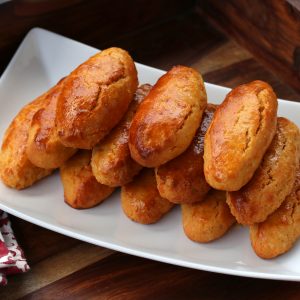
Broas Castelares (Portuguese Sweet Potato Cookies)
Ingredients
- 3/4 pounds sweet potatoes , scrubbed
- 3 1/2 cups granulated sugar
- zest of one lemon
- zest of half an orange
- 2-3 tablespoons finely chopped candied ginger
- 1 cup shredded dried coconut
- 1 1/2 cups super fine blanched almond meal
- 3/4 cups finely ground cornmeal
- 1/2 cup all-purpose flour
- 1/4 teaspoon salt
- 2 large eggs
- 1/4 teaspoon orange blossom water (optional)
- 1 large egg yolk for brushing
Instructions
- Pierce the sweet potatoes all over with a fork and bake in the oven at 400 degrees F for 45 minutes or until soft. Let it cool a few minutes then scrape out the flesh.
- Run the sweet potato flesh through a potato ricer. Place it in a small-medium pot with the sugar. Stir over medium heat until the sugar is dissolved to liquid. Add the lemon zest, orange zest and candied ginger. Increase the heat to medium-high and simmer the mixture for 5 minutes, stirring constantly to prevent scorching. Remove from heat and add all remaining ingredients except for the eggs, orange blossom water and egg yolk. Stir to thoroughly combine. Then add the eggs and orange blossom water and stir to thoroughly combined. Let the mixture cool, cover with plastic wrap and refrigerate overnight to let the flavors meld and the dough firm up.
- Preheat the oven to 375 degrees F. Use a spoon to scoop out the dough and roll into balls about 1 1/2 to 1 3/4 inches in diameter. Then shape each ball into an oval with tapered ends. Place the cookies on a lined baking sheet and gently press them just to very slightly flatten them (see images in blog post) and brush them with the egg yolk. Bake for 15-20 minutes until lightly browned. Let cool completely.
- Makes about 30 cookies. These freeze well in an airtight container or ziplock bag.
Notes

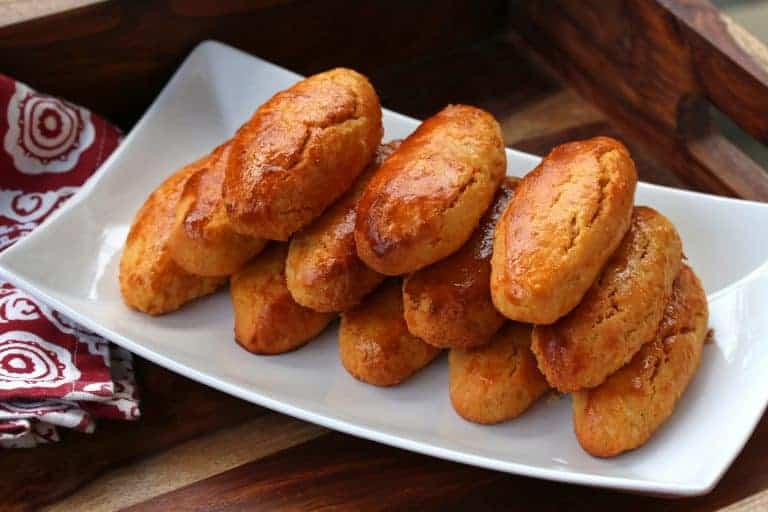
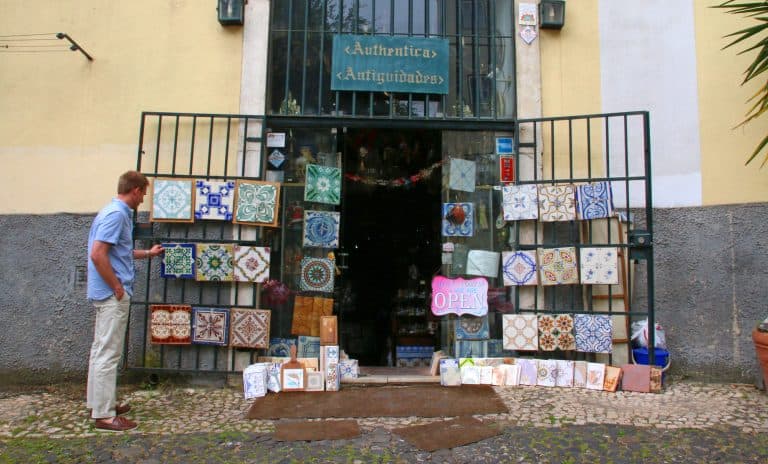
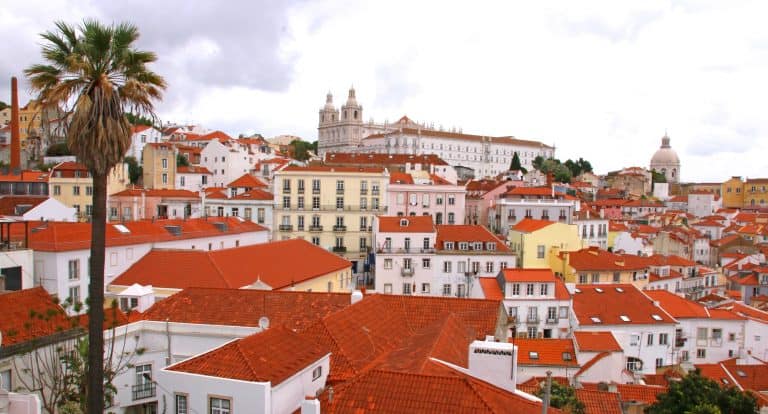
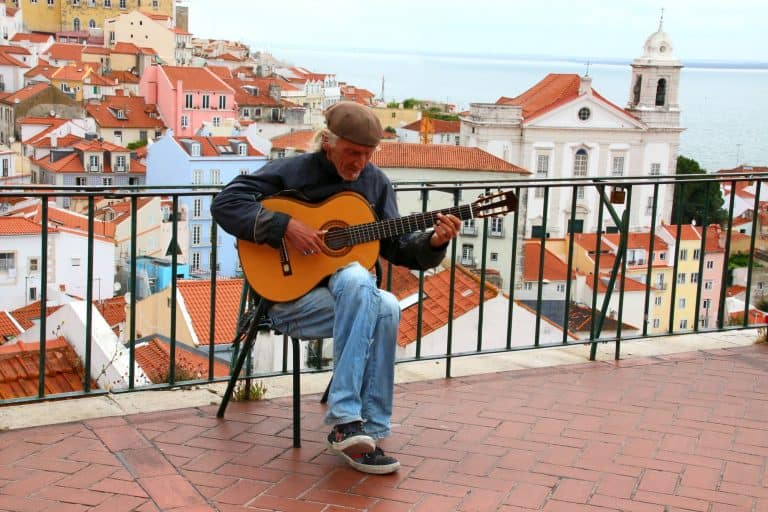
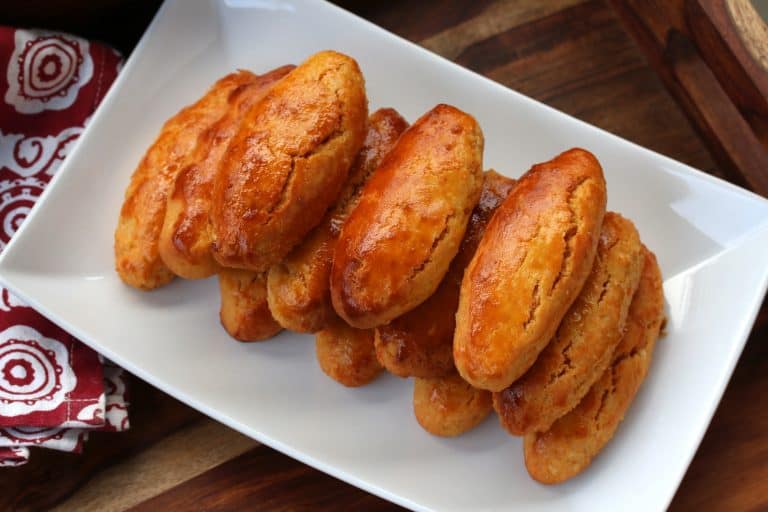
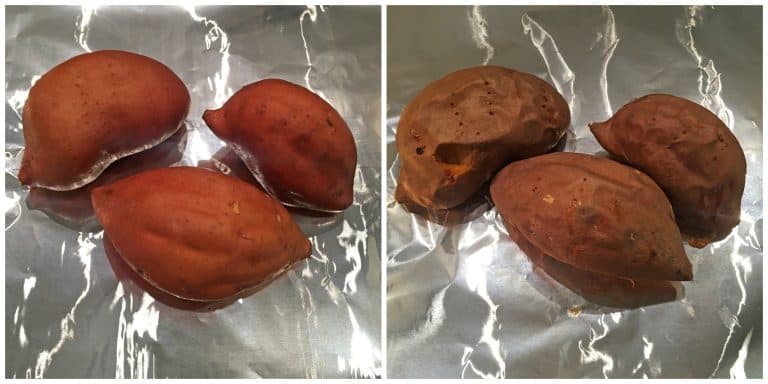
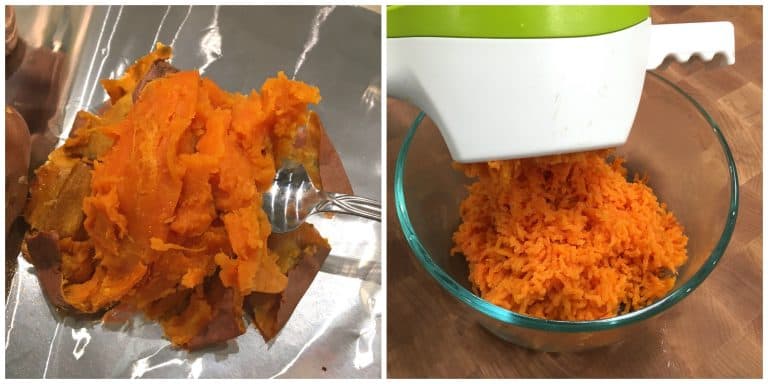
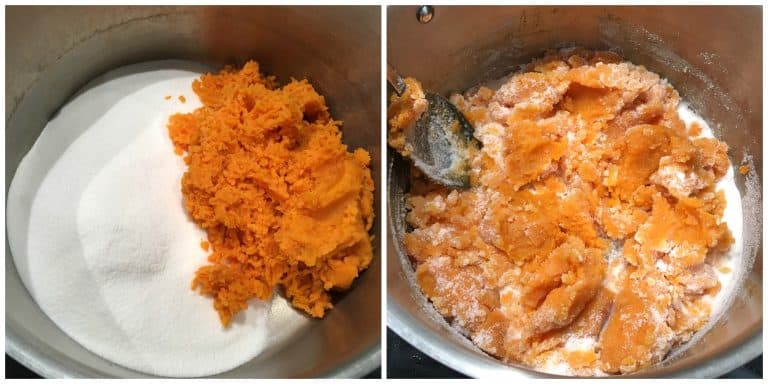
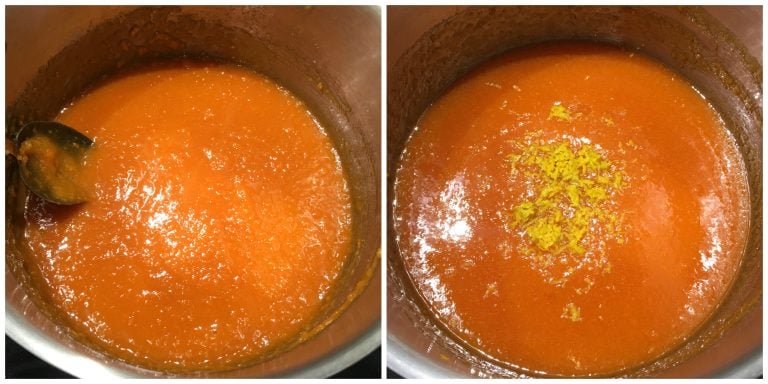
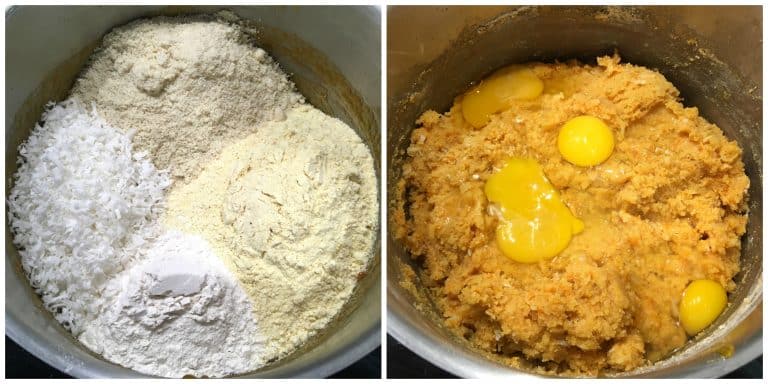
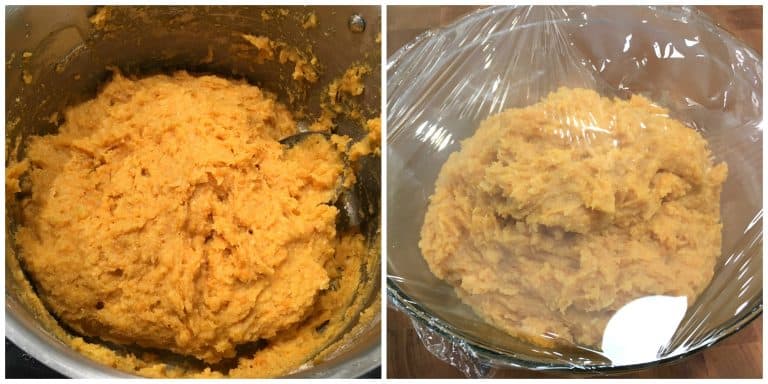

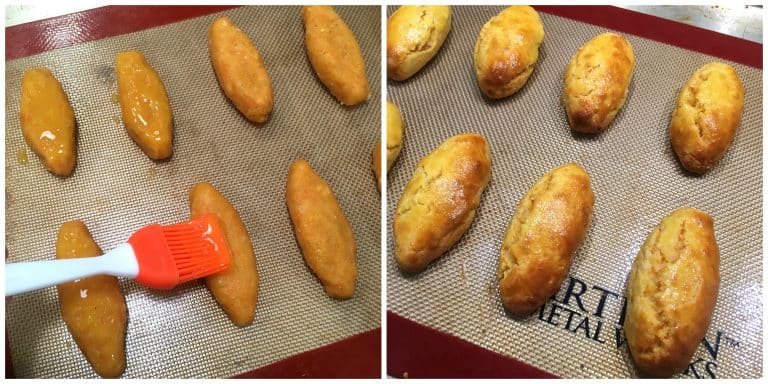
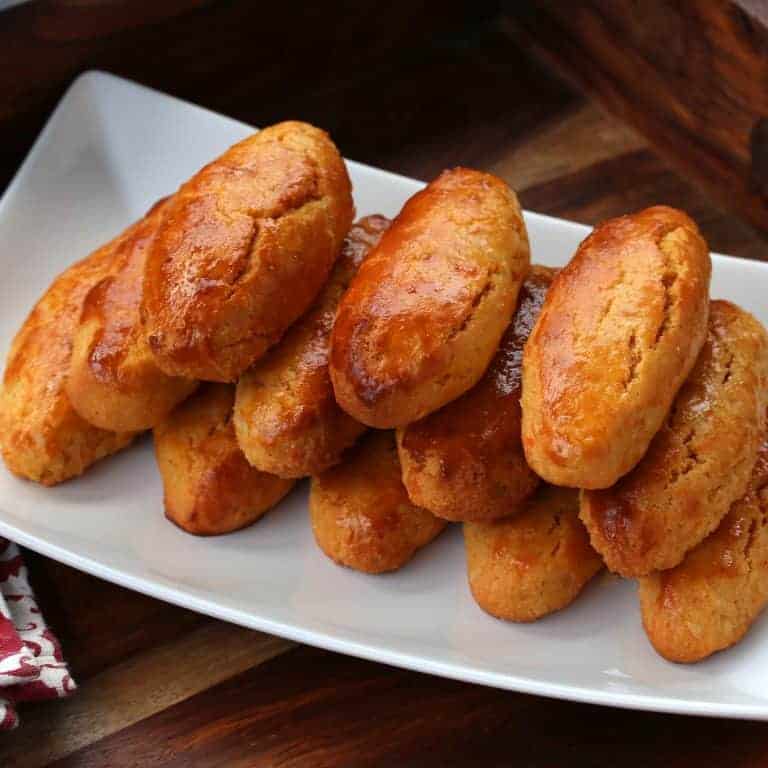
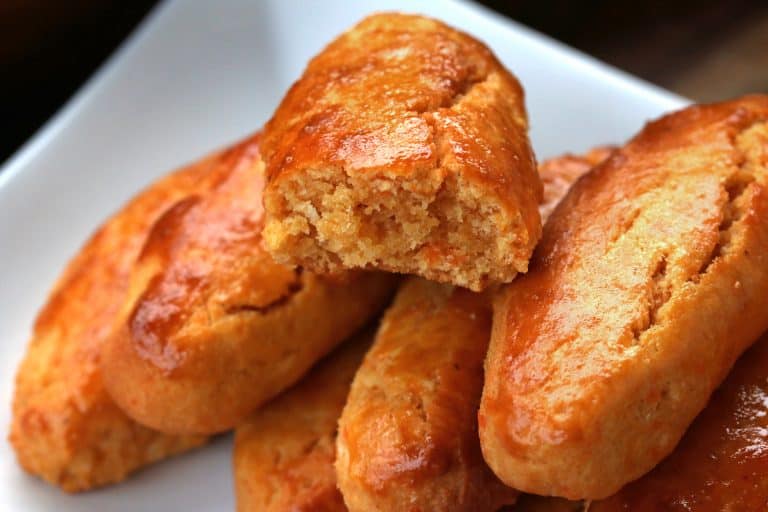


















Thank you for sharing the recipe! I was really excited to try these because I just love sweet potato! They didn’t turn out for me.
I am not sure if they’re supposed to turn out very sticky and chewy, almost like they didn’t bake through. Mine turned out very sticky and chewy, way too much for my liking anyways.
They don’t have a sweet potato flavor at all. The coconut in them overpowers everything. I also find them unbearably sweet. Made my tummy sick. I was wondering about the amount of sugar in the recipe, but still proceeded believing that it would all come together somehow.
Unfortunately I have never been to Portugal to try the real thing to compare, so I wouldn’t know if it’s me who just doesn’t like them or the recipe that hasn’t worked. I imagine there are different variations in different regions. I will research further.
My son and I tried the recipe this weekend and we followed all the steps and formed them into the correct shape but while in the oven they flattened out. Is it because we used almond flour and not blanched almond flour? We were quite disappointed that they came out flat.
Any advice would be appreciated if anybody’s run through this and know how to correct it for our next attempt.
Hi Mike, that’s really odd. No, non-blanched versus blanched wouldn’t cause that. Did you make any other substitutions and change any ingredients? Was your dough as stiff as it shows in the pictures when you shaped them?
The only ingredient that we did not have was the orange blossom water. No other substitutions were made. The dough was stiff and sticky as in the photos. I wonder if I did not pack the dough hard enough while shaping them to remove excess air. I’ll have to try again and see.
Mike
Hi there. Thank you for the lovely words about my city! As a Portuguese that actually does these quite a lot, I just want to add my 2 cents :) One is that I’ve never seen ginger put into it (don’t get me wrong, it seems lovely, but it’s just not traditional). The other is regarding cornmeal. While it’s true cornmeal is added in many recipes, it often was to make the broa cheaper… leaving it out makes the broa much more delicate. Try it out. Plain flour is not used AT ALL. Unless it’s a very commercial broa. Also, flatten the broad a bit just before brushing them with eggs. leave a small indentation so that there«s more egg yolk on top – it will get a nice, dark color very typical in broad. Looking forward to seeing more traditional Portugues recipes!
Hi Rita, thank you for that feedback. I’ll definitely give the variation without the cornmeal a try. What do you use instead of plain flour?
Hi Kimberly,
As I said, cornmeal is used in some broas, but they should be named “broas de milho” (corn broas) for transparency :)
Traditional broas castelares have no flour whatsoever, only sweet potato, almond meal, coconut shreds, sugar, orange blossom water and plenty of egg yolks, as typical in Portuguese desserts (I do add lemon and orange zest, but I don’t think they did, back in the day). We then cook the mixture after adding the egg yolks (at a low temp), stirring often, until it thickens. Then you’ll have to leave it in the fridge overnight to them mould them and cook them in the oven. They’re very moist and dense and quite nice. Try it and let me know – I might be biased!I can get you a detailed recipe, for sure.
Awesome, thanks for that info, Rita!
Truth be told, my proportions are also quite different… I’d use for 650 gr of sweet potato, 200 gr of almond, 6 egg yolks, 500 gr of sugar and 100 gr of coconut. plus egg yolks for brushing
Is there any way I can cut back on the sugar on these? 3 1/2 cups is a lot
Hi Shane, Broas Castelares do traditionally call for a lot of sugar. What’s actually really surprising though is that even with that amount of sugar they’re not overly sweet. Yes, you can certainly cut back on the sugar if you like.
No baking powder or baking soda? Just curious. Mine didn’t rise very much. Is this normal?
Hi Paula, yes that’s correct. These aren’t really supposed to rise, they are a very dense “cookie.”
Is the almond meal necessary? Any substitutions? We have nut allergies. Thanks!
Hi Christa, almond meal is a traditional and integral ingredient in these cookies, they contribute both flavor and texture. You can substitute more flour in its place, just know that it won’t taste quite like Broas Castelares.
👍🏼😊Thank you!
Thank you for a new Christmas treat! Wanted to try something new this year and these were favourites from family and cousins alike. They will definitely be at our Christmas feast for 2019 !
I’m so happy to hear that, Jeff, thanks for the feedback!
I spent a week in Portugal in the mid nineties and found the country fascinating! I would go back in a heartbeat! Thank you for sharing your photos, a lovely reminder!
These are definitely going on my holiday cookie bake list this year! 31/2 cups of sugar! Wow! But then I remember the bakeries throughout Portugal and watching folks pile three or four different pieces of pastry onto their plates and look at my one piece, and every cup of coffee was served with at least four packets of sugar, whether you wanted it or not!
The shape of these cookies are like the French Navette cookie which I discovered in Nice last Christmas. Have you a recipe for the Navette?
It has a lovely origin story as well.
Hi Laurie! Agreed, there is so much in Portugal worth exploring and we want to go back again as well. Yes, 3 1/2 cups of sugar and that’s LESS than what virtually every other Portuguese recipe calls for! They definitely have a sweet tooth over there :)
It has been AGES since I’ve had a Navette and completely forgot about them until you mentioned it – thanks for reminding me. I’ve had the traditional version with orange blossom water but haven’t tried any of the other flavor variations. Which ones did you try and like best? Yes, the story behind them really is lovely.
I’ve been to Madeira but not the mainland. Hope I get to see it someday because omg those tiles!!! Until then I’ll have to make these cookies!
I’ve never tried these before. They look so delicious!
I love your travel recipes. They make me want to take off and explore the whole world!